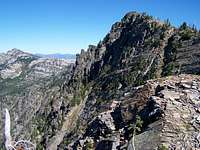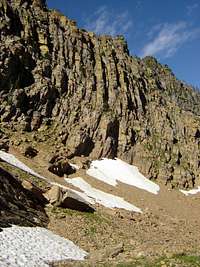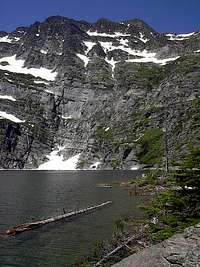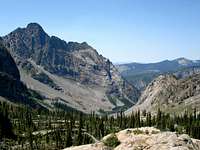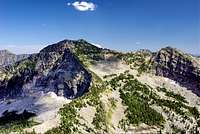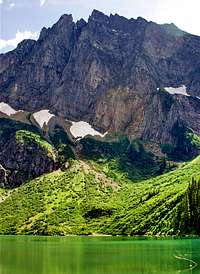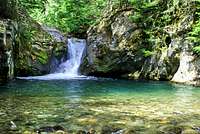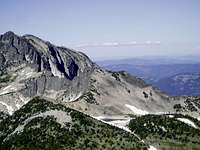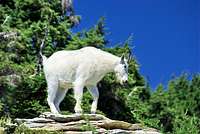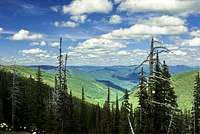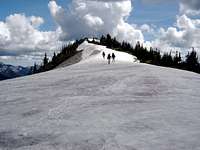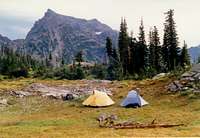|
|
Area/Range |
|---|---|
|
|
48.22250°N / 115.68861°W |
|
|
Hiking, Mountaineering, Trad Climbing, Scrambling |
|
|
Spring, Summer, Fall |
|
|
Overview
The Cabinet Mountains are part of the Rocky Mountains, located in northwest Montana and the panhandle of Idaho, in the United States. The mountains cover an area of 2,134 square miles (5,527 km²), over 2 million acres. The highest peaks are Snowshoe Peak (8,736 ft, 2,663 m), "A" Peak (8,634 ft, 2,632 m), and Bockman Peak (8,174 ft, 2,491 m). Other high mountain peaks include Elephant (7938 ft, 2,420 m), St. Paul (7714 ft, 2,351 m), Treasure Mountain (7694 ft, 2,345 m), Ibex (7676 ft, 2,340 m), Bald Eagle (7655 ft, 2,333 m) and Mt. Snowy (7618 ft, 2,322 m).
Although this range is one of only four (out of 30) in Montana that does not have any 9,000-foot peaks, the Cabinets are impressive because of the low elevation at which its valleys are situated. From the Bull River valley, Snowshoe Peak rises over 6,300 feet!
The geology of the Cabinet Mountains share many similarities with the Purcell and Selkirk Mountains. The range's foundation is Precambrian Belt Supergroup rocks, which were carved and shaped by Pleistocene glaciation.
To the west and extending north are the Selkirks; in the extreme northeast corner of Idaho, northwest Montana and stretching into Canada are the Purcells; the Salish Mountains, a small range entirely located in Montana, flank the Cabinets to the northeast; and straddling the Idaho-Montana border along the southwest edge of the Cabinets lie the northernmost part of the Bitterroots.
Ranging from the high, rocky peaks, to groves of huge cedars in the canopied valleys, the Cabinets have a lot to offer. Hidden in the peaks and ridges are scores of deep blue lakes, feeding clear, cold streams that tumble to moose country below.
It is said that the Cabinets got their name from the French explorers who named these mountains for their cabinet-like appearance when viewed from the valley floor.
The Cabinet Mountain Wilderness Area
The Cabinet Mountains Wilderness offers 94,272 acres of rugged, mountainous terrain in the Kootenai National Forest. It is located in northwestern Montana approximately 15 miles southwest of Libby, Montana. More than 30 trails lead into the Wilderness Area. Primitive camping is allowed with no public facilities.
Designated a Primitive Area in 1935, the area then became part of the National Wilderness Preservation Act of 1964, and is defined as "an area where the earth and its community of life are untrammeled by man, where man himself is a visitor who does not remain...."
Proposed Scotchman Peaks Wilderness
Roughly 60 miles south of Canada, the 88,000 acre Scotchman Peaks roadless area spans the Idaho-Montana border. Since the 1970s, when the U.S. Forest Service carried out extensive evaluations of lands suitable for wilderness, this rugged, scenic and biologically diverse portion of the Cabinet Mountains has been managed for its wilderness potential. However, in the past three decades much has changed in the process of determining the best use of public lands and resources, including who gets to make those decisions. If we don't make our opinions heard then we risk losing this vital wilderness.
Leaving them unprotected means that these beautiful public lands could potentially be taken away from us without our consent or even our knowledge, and sold to be developed, thus destroying forever the homes of numerous animals and your opportunity to enjoy some of the few remaining public wilderness areas available.
If you would like to help make this area a truly protected Wilderness visit www.scotchmanpeaks.org
Flora and Fauna
The list of resident animals is extensive and their homes varied - from the high rocks of the mountain goat, mountain sheep, pika and golden eagle, to the lower slopes and brushy canyon bottoms of the beaver, woodrat, and beautiful Western Tanager, other animals include wolverines, deer, elk, and moose. Cutthroat, rainbow, and brook trout have been introduced and are now found in many lakes, streams and beaver ponds. The wide range of ecosystems has created a great diversity of plants. You can find the giant Western Red Cedar and prickly Devils Club in moist, lower valleys, midslopes produce Douglas Fir and huckleberries, and on the windswept ridges are the gnarled Whitebark Pine and stunted heath. Wildflowers scent the mountain air. Fall usually arrives in September, and with it a wonderful assortment of Mountain Maple scarlets, Mountain Ash reds, Alder browns, and the Larch golden yellows.
Grizzlies, black bears and other large wildlife may be encountered here. Use proper food storage, keep a clean, odorless camp, and avoid close confrontations. Males in the fall, and mothers with young may be aggressive if you get too close, so view them from a safe distance. Firearms are not necessary.
Getting There
The Cabinet Mountains Wilderness is located in northwestern Montana just southwest of Libby, Montana. Major highways providing access to the Wilderness Area are Montana State Highways 200, 56 and US Highway 2.
The Proposed Scotchman Peaks Wilderness straddles the Montana/Idaho border, east of Sandpoint, ID. Major Highways providing access to this area are State Highways 200 and 56.
Camping
Make camps away from lakeshores or from areas where others may also be seeking solitude. Use any existing fire rings first, but when constructing your own, scatter the rocks away from the campsite when done, or use a shallow pit in place of the fire ring. Replace the soil in the pit before you leave. Use only dead wood, and remember to always use extreme caution with fire.
Red Tape
Climbers, hikers and backpackers are encouraged to "Pack it In and Pack it Out" and practice minimal impact camping techniques, including proper food storage and waste disposal techniques. The Cabinets are home to many species of wildlife, including black and grizzly bears. Visitors are strongly advised to check in with the local Forest Service office for current trail conditions and advisories before venturing into the wilderness area.
When venturing off trail to climb, be aware that most of the rock in the cabinet mountains is sedimentary and rotten.
External Links
www.fs.fed.us/r1/kootenai/about/forest/featured_areas/cabinet_wilderness.shtml
www.libbymt.com/areaattractions/cabinetmountains.htm
www.scotchmanpeaks.org
| Trails of the Wild Cabinets by Dennis Nicholls Available for purchase at Keokee Books |
Here's a video of Rock Lake by Alpendave:
Rock Lake.MOV



